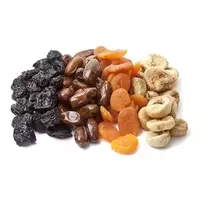Dried fruits

The national cuisine of almost any country in the world has in its stock recipes for cooking dishes using dried fruits. It is customary to combine them with meat and fish, potatoes and rice, and use them when sourcing vegetables. In addition, the nutritional properties of dried fruits make them integral components of various types of pastries, breakfast cereals, granola and other sweets.
A wide range of dried fruits allows you to come up with new and new culinary masterpieces, the cooking options of which depend solely on the imagination and skill of the cook.
Types of dried fruits
First of all, it should be noted that the main division of dried fruit types directly depends on the varieties of raw materials used. Thus, if fresh fruits are used during drying, one type of dried fruit is obtained. In the case of berries - the second. Around the world, dried fruits such as:
dried apricots - uryuk (with stones) and dried apricots (without stones);
prunes;
dates;
dried apples;
dried pears;
dried bananas;
dried melon;
dried peaches;
dried figs;
dried mango;
dried papaya;
dried persimmon;
dried pineapple;
dried coconut;
dried kumquat.
Some of them, characterized by special sweetness, can be safely attributed to candied fruits. As for dried fruits based on fresh berries, the following species stand out: raisins (dried grapes), dried rose hips, dried cranberries and dried barberry.
Composition of dried fruits
The composition of dried fruits is simply replete with useful substances, such as vitamins (A, groups B, PP, C) and mineral elements (iron, magnesium, calcium, potassium, phosphorus, sodium). It is known that the calorie content of dried fruits is much higher than the nutritional value of fresh fruits - about 250 kcal per hundred grams.
This product has a long shelf life and is not necessarily in a cool place. This is one of their main advantages - in this regard, they are a convenient alternative to fresh fruits. However, unfortunately, during the drying process, most of vitamin C leaves the dried fruit.
Benefits of dried fruits
It's no secret that all fruits are full of trace elements and vitamins, so the benefit of dried fruits lies not only in their preservation, but also in their increase. Calcium in dried fruits helps to strengthen bones, makes nails and hair healthy, and also improves the appearance of the skin. Potassium in dried fruits normalizes heart function and strengthens nerves. Iron and sodium maintain the balance of hemoglobin in the blood, and magnesium is responsible for blood pressure.
In addition, the benefits of dried fruits for the normal digestion process are due to the presence of fiber, which makes the gastrointestinal tract function correctly. And vitamins, let alone make dried fruits undoubtedly useful.
Harm to dried fruits
The dangers of dried fruits are mentioned based on the fact that they contain a large amount of carbohydrates, and therefore it is not worth abusing this treat for people with diabetes due to a possible increase in blood sugar levels. In addition, it is not recommended to eat dried fruits in inflammatory exacerbations of the stomach and duodenum.
dried fruits 216.3 kCal
Energy value of dried fruits (Ratio of proteins, fats, carbohydrates - ju):
Proteins: 2.8 g (~ 11 kCal)
Fats: 0 g (~ 0 kCal)
Carbohydrates: 51.3 g (~ 205 kCal)
Energy ratio (bj | y): 5% | 0% | 95%
 Español
Español Français
Français Português
Português Русский
Русский 简体中文
简体中文 繁體中文
繁體中文 日本語
日本語 한국어
한국어 العربية
العربية Türkçe
Türkçe Қазақ
Қазақ Deutsch
Deutsch Italiano
Italiano Українська
Українська
